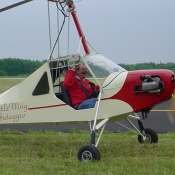I began my involvement with gyros by building a Bensen B-8M in 1975. I had never even flown in an airplane prior to this. I diligently followed Dr. Bensen's manual and within a couple of months I was flying this thing. I accumulated a couple of hundred hours with the Bensen before I became a little concerned about the continued problem of "Pushovers". There seemed to be an awful lot of people dying exactly the same way. 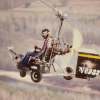 I finally decided to sell the Bensen but I continued to fly an old Taylorcraft airplane I had bought. I sold the gyro to a Bensen dealer for him to re-sell. The fellow he sold it to was dead within the week. Another "Pushover". I began to research the history of the Autogiro and was amazed to find that they NEVER experienced such an event as the "Pushover". The original Autogiros flew for 10 years before anyone was ever killed in one! In the entire twenty-year period that they were actively flown there were only 6 fatalities worldwide and NONE due to a "Pushover".
I finally decided to sell the Bensen but I continued to fly an old Taylorcraft airplane I had bought. I sold the gyro to a Bensen dealer for him to re-sell. The fellow he sold it to was dead within the week. Another "Pushover". I began to research the history of the Autogiro and was amazed to find that they NEVER experienced such an event as the "Pushover". The original Autogiros flew for 10 years before anyone was ever killed in one! In the entire twenty-year period that they were actively flown there were only 6 fatalities worldwide and NONE due to a "Pushover".
Well, it seems to me there should be a lesson here. The Sunstate Rotor Club had been very active in trying to find a remedy for these type accidents. Chuck Beaty, in particular, became very vocal concerning the need to align the thrust-line of the propeller with the center of gravity (vertical position). From this the Dominator gyros emerged. This was a great improvement. In fact, Cierva had patented the concept of aligning the propeller thrustline with CG (For increased longitudinal stability) very early in the Autogiro's development. Yet, there is still more to making an aircraft stable. This missing ingredient in the Bensen type gyro was the horizontal tail. Sure, people would remind me that the Bensen had a horizontal stabilizer. Nonsense! Not nearly enough surface area and not nearly enough leverage (not far enough back). The Autogiros of old had huge horizontal tails and tractor mounted propellers which were located in the center of aircraft drag and center of gravity. These aircraft were forgiving and pitch-stable. Here was the lesson. BUILD THE AIRCRAFT PROPERLY and you would have no stability problems. So, instead of copying the Bensen, as everyone else was doing, I "copied" the noble Spaniard, Senor Don Juan de la Cierva Codorniu.....the father of practical rotorcraft.
I was so intent on making my craft "Bunt-proof" that my first 2 prototypes utilized elevators for longitudinal (pitch) control. I knew that this means of control would provide positive control without the typical "control lag" experienced in many rotorcraft. Also, elevator control is not "G" sensitive. On these craft I locked the rotorhead in the fore-aft position and designed a means of trimming it for fine adjustments. I used side-ways tilting of the head for lateral control. The first of these prototypes was the LW-1.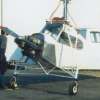 I built it from a wrecked Piper airplane fuselage. I designed and built a rotor pylon which was attached to the fuselage through four large isolation dampers. I designed a wide outrigger type landing gear with oleo struts. This aircraft was powered by a Continental 0-200 engine of 100 horsepower. Lateral control was accomplished by using push-pull cables directly connected to the control torque tube. I developed centrifugal flyweights for the rotorhead to prevent the two-bladed rotor from flapping into the tail at low rotor speeds. I used an automotive starter for a prerotator to start the blades.
I built it from a wrecked Piper airplane fuselage. I designed and built a rotor pylon which was attached to the fuselage through four large isolation dampers. I designed a wide outrigger type landing gear with oleo struts. This aircraft was powered by a Continental 0-200 engine of 100 horsepower. Lateral control was accomplished by using push-pull cables directly connected to the control torque tube. I developed centrifugal flyweights for the rotorhead to prevent the two-bladed rotor from flapping into the tail at low rotor speeds. I used an automotive starter for a prerotator to start the blades.
This aircraft was taxi tested and then test flown. It flew remarkably easy. It also had no stick shake. It was, however, not a very good performer due to its weight and the small diameter rotor I was using for testing. I was , primarily, using this machine as a "proof-of-concept" aircraft anyway. The concept seemed to be on target. I immediately began building the LW-2. This was to be an ultralight version of the LW-1.
Within two months we (three of us) had it built and assembled. Basically, it was a scaled-down Piper Cub type frame which we built from start to finish with new 4130 chromoly steel tubing. Initial flight testing was done without paint or fabric installed. It was powered by a McCulloch drone engine (removed from an old Bensen). 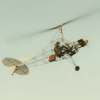 Its initial flights were without incident and without any difficulty. These are recorded on VHS video (as are the first flights of LW-1). After a few flights we tore it down and painted everything and reassembled it, still without fuselage fabric. I flew it an additional 15 hours before tearing it down for a complete fabric job to get it ready to show. This took it out of the "ultralight" category which limited it to 254 Ib. I flew this machine many hours with the McCulloch engine without any difficulty. However, most people had a negative attitude toward the McCulloch, so I replaced it with a water-cooled AMW engine of 70 horsepower. This engine featured dual ignition, alternator and electric start.
Its initial flights were without incident and without any difficulty. These are recorded on VHS video (as are the first flights of LW-1). After a few flights we tore it down and painted everything and reassembled it, still without fuselage fabric. I flew it an additional 15 hours before tearing it down for a complete fabric job to get it ready to show. This took it out of the "ultralight" category which limited it to 254 Ib. I flew this machine many hours with the McCulloch engine without any difficulty. However, most people had a negative attitude toward the McCulloch, so I replaced it with a water-cooled AMW engine of 70 horsepower. This engine featured dual ignition, alternator and electric start. 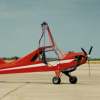 I showed this aircraft at the PRA International Convention and EAA's Oshkosh in 1995, '96 and '97. It proved to be a remarkably stable craft. It was somewhat difficult to handle on the ground in a strong wind due to the inability to move the rotor in the fore-aft direction. I learned to deal with this by turning the aircraft sideways to the wind and tipping the disc laterally, into or away, from the wind as was required. This craft was so stable that I was prepared to compare it to a similar machine with a fully tilting head. Thus, LW-3 was born.
I showed this aircraft at the PRA International Convention and EAA's Oshkosh in 1995, '96 and '97. It proved to be a remarkably stable craft. It was somewhat difficult to handle on the ground in a strong wind due to the inability to move the rotor in the fore-aft direction. I learned to deal with this by turning the aircraft sideways to the wind and tipping the disc laterally, into or away, from the wind as was required. This craft was so stable that I was prepared to compare it to a similar machine with a fully tilting head. Thus, LW-3 was born.
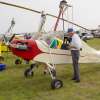 This craft was built with some other changes implemented besides the control method. I built a shock absorbing, outrigger landing gear for it. I decided to use a four-stroke engine and settled on a 2180cc Volkswagen conversion with dual ignition. I designed a rotor brake and a simple electric prerotator. I continued to utilize the centrifugal flyweights and also designed a control stick lock to hold the stick full forward any time the craft was operated on the ground prior to take-off and after landing. This precluded the rotor contacting the tail prior to the blades reaching stable speed prior to take-off and as the rotor slowed after landing. Remember, the LW-2 did not move the head in the fore-aft direction so rotor-to-tail interference wasn't as much an issue as it was now with fully tilting controls.
This craft was built with some other changes implemented besides the control method. I built a shock absorbing, outrigger landing gear for it. I decided to use a four-stroke engine and settled on a 2180cc Volkswagen conversion with dual ignition. I designed a rotor brake and a simple electric prerotator. I continued to utilize the centrifugal flyweights and also designed a control stick lock to hold the stick full forward any time the craft was operated on the ground prior to take-off and after landing. This precluded the rotor contacting the tail prior to the blades reaching stable speed prior to take-off and as the rotor slowed after landing. Remember, the LW-2 did not move the head in the fore-aft direction so rotor-to-tail interference wasn't as much an issue as it was now with fully tilting controls.
This aircraft flew exceptionally well from the very beginning. Any fears of it being anything less than completely stable were quickly squelched. I used the same horizontal stabilizer as LW-2 but omitted the elevator. After about 20 hours of flight, I designed a special damper system for the rotor pylon. This diminished the two-per-rev vibrations typically felt in two-biaded rotor systems, This craft has been a pleasure to operate and I hope to see others build these machines and experience the same things I have.
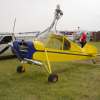 The next logical step was to develop a two-place version. I have completed the prototype, based on the LW-2 and LW-3 single-place models. I have not yet had time to complete the test program. Hopefully, very soon.
The next logical step was to develop a two-place version. I have completed the prototype, based on the LW-2 and LW-3 single-place models. I have not yet had time to complete the test program. Hopefully, very soon.
I have recently made arrangements to have the fuselage assemblies built by a professional welding firm and am working on completing arrangements for the various other components to be built in mass. Ultimately, I hope to have a complete kit package available. These things take time and money.
In closing, I would like to re-emphasize the importance of a properly configured gyroplane to achieve proper flight stability. While it is most certainly possible to fly the tail-less, pusher types with proper training and caution, it doesn't change the fact that they can (and often, do) bunt-over if mishandled. This is 100% fatal!
The tractor configured autogyro has several other features that make it an appealing option, in addition to the stability issues. These include the ability to use longer, more efficient propellers. They are less noisy than pusher configurations. There is less danger of something coming loose from the craft and passing through the propeller and the enclosed cockpit offers more protection in the event of an accident.
If anyone wishes further information, feel free to contact me.
Sincerely,
Ron Herron
Little Wing Autogyros, Inc.
E-mail: rotopup@aol.com
Personal notes:
I am an active pilot with airplane and rotorcraft-gyroplane ratings. I have approximately 1500 hours flying time, 500 being in gyroplanes. I am a licensed airframe and powerplant mechanic (A&P) with inspection authorization (IA). I am an instructor of aviation maintenance at Pulaski Technical College in North Little Rock , Arkansas.
All models of Little Wing Autogyros were designed, built and test flown by me. Merrel Blalock did a lot of the work on these models, including all fabric work and paint. Harold Settle helped in the developmental stages of LW-1 and LW-2. Harold and Merrel worked for me when I ran Little Wing Aviation, an aircraft maintenance facility on the North Little Rock, AR airport. (1M1)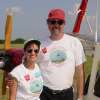 Kristine Irvin, my beloved fiancee, has been actively involved financially and emotionally. She is my advisor on many important matters concerning the Little Wing Autogyro and, in fact, owns half the company. She is also an active pilot and owns a Beechcraft Bonanza and half-ownership of our McCulloch J-2 gyroplane.
Kristine Irvin, my beloved fiancee, has been actively involved financially and emotionally. She is my advisor on many important matters concerning the Little Wing Autogyro and, in fact, owns half the company. She is also an active pilot and owns a Beechcraft Bonanza and half-ownership of our McCulloch J-2 gyroplane.
